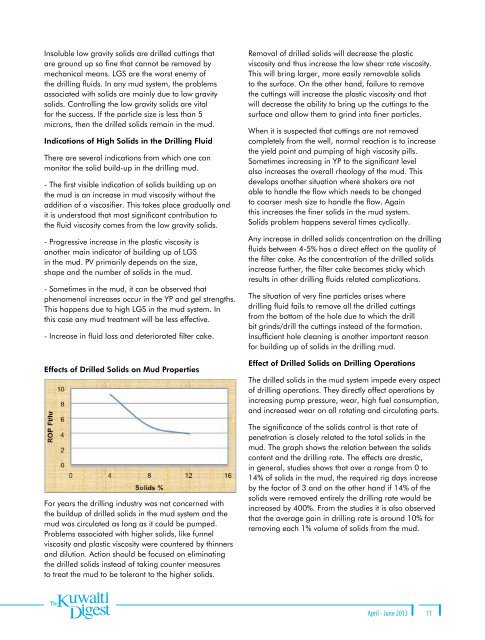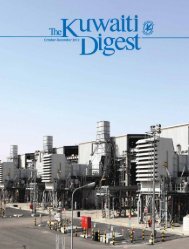6 - Kuwait Oil Company
6 - Kuwait Oil Company
6 - Kuwait Oil Company
Create successful ePaper yourself
Turn your PDF publications into a flip-book with our unique Google optimized e-Paper software.
Insoluble low gravity solids are drilled cuttings that<br />
are ground up so fine that cannot be removed by<br />
mechanical means. LGS are the worst enemy of<br />
the drilling fluids. In any mud system, the problems<br />
associated with solids are mainly due to low gravity<br />
solids. Controlling the low gravity solids are vital<br />
for the success. If the particle size is less than 5<br />
microns, then the drilled solids remain in the mud.<br />
Indications of High Solids in the Drilling Fluid<br />
There are several indications from which one can<br />
monitor the solid build-up in the drilling mud.<br />
- The first visible indication of solids building up on<br />
the mud is an increase in mud viscosity without the<br />
addition of a viscosifier. This takes place gradually and<br />
it is understood that most significant contribution to<br />
the fluid viscosity comes from the low gravity solids.<br />
- Progressive increase in the plastic viscosity is<br />
another main indicator of building up of LGS<br />
in the mud. PV primarily depends on the size,<br />
shape and the number of solids in the mud.<br />
- Sometimes in the mud, it can be observed that<br />
phenomenal increases occur in the YP and gel strengths.<br />
This happens due to high LGS in the mud system. In<br />
this case any mud treatment will be less effective.<br />
- Increase in fluid loss and deteriorated filter cake.<br />
Effects of Drilled Solids on Mud Properties<br />
For years the drilling industry was not concerned with<br />
the buildup of drilled solids in the mud system and the<br />
mud was circulated as long as it could be pumped.<br />
Problems associated with higher solids, like funnel<br />
viscosity and plastic viscosity were countered by thinners<br />
and dilution. Action should be focused on eliminating<br />
the drilled solids instead of taking counter measures<br />
to treat the mud to be tolerant to the higher solids.<br />
Removal of drilled solids will decrease the plastic<br />
viscosity and thus increase the low shear rate viscosity.<br />
This will bring larger, more easily removable solids<br />
to the surface. On the other hand, failure to remove<br />
the cuttings will increase the plastic viscosity and that<br />
will decrease the ability to bring up the cuttings to the<br />
surface and allow them to grind into finer particles.<br />
When it is suspected that cuttings are not removed<br />
completely from the well, normal reaction is to increase<br />
the yield point and pumping of high viscosity pills.<br />
Sometimes increasing in YP to the significant level<br />
also increases the overall rheology of the mud. This<br />
develops another situation where shakers are not<br />
able to handle the flow which needs to be changed<br />
to coarser mesh size to handle the flow. Again<br />
this increases the finer solids in the mud system.<br />
Solids problem happens several times cyclically.<br />
Any increase in drilled solids concentration on the drilling<br />
fluids between 4-5% has a direct effect on the quality of<br />
the filter cake. As the concentration of the drilled solids<br />
increase further, the filter cake becomes sticky which<br />
results in other drilling fluids related complications.<br />
The situation of very fine particles arises where<br />
drilling fluid fails to remove all the drilled cuttings<br />
from the bottom of the hole due to which the drill<br />
bit grinds/drill the cuttings instead of the formation.<br />
Insufficient hole cleaning is another important reason<br />
for building up of solids in the drilling mud.<br />
Effect of Drilled Solids on Drilling Operations<br />
The drilled solids in the mud system impede every aspect<br />
of drilling operations. They directly affect operations by<br />
increasing pump pressure, wear, high fuel consumption,<br />
and increased wear on all rotating and circulating parts.<br />
The significance of the solids control is that rate of<br />
penetration is closely related to the total solids in the<br />
mud. The graph shows the relation between the solids<br />
content and the drilling rate. The effects are drastic,<br />
in general, studies shows that over a range from 0 to<br />
14% of solids in the mud, the required rig days increase<br />
by the factor of 3 and on the other hand if 14% of the<br />
solids were removed entirely the drilling rate would be<br />
increased by 400%. From the studies it is also observed<br />
that the average gain in drilling rate is around 10% for<br />
removing each 1% volume of solids from the mud.<br />
April - June 2013 11

















